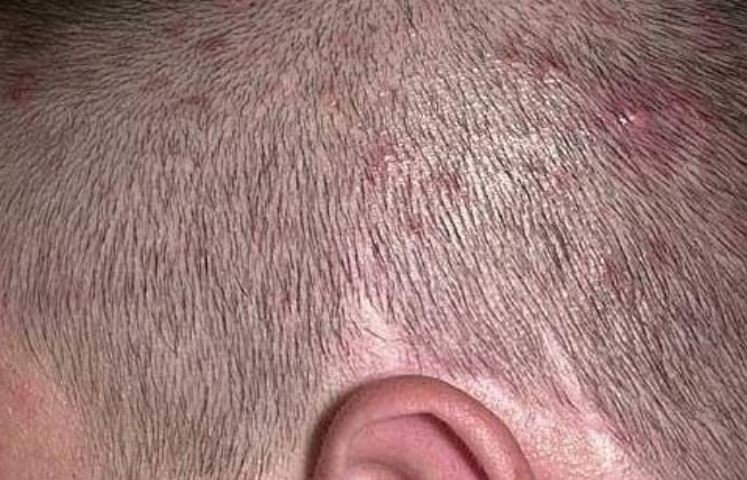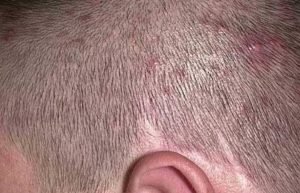

Scalp folliculitis is characterized by an itchy scalp with pustules that are small. The lesions can be few or many and are very itchy.
Folliculitis is a condition where hair follicles become inflamed. It can be due to a fungal or bacterial infection. They pustules will first look like small red or white bumps around the hair follicles. The infections can spread and turn to crusty sores if not treated. Severe infections cause hair loss and scarring. Mild cases however clear easily with basic self-care.
Scalp folliculitis is considered an inflammatory reaction to an accumulation of hair follicle components, especially micro-organisms. These microorganisms include bacteria, yeast, and mites.
The accumulation of these microorganisms is brought on by:

How it may look like at times
Severe cases of scalp folliculitis cause acne necrotica. This causes larger papules which get inflamed and develop black crusts. This then leaves permanent scars on the scalp that look like those of chicken pox.

Scalp folliculitis picture
Another form is known as Perifolliculitis capitis abscedens et suffodiens. This is a rare but very severe form of folliculitis that often affects black adult men. Large nodules and cysts appear on the scalp accompanied by other smaller pustules and papules from which discharge comes out. It may cause temporary hair loss and the lesions will eventually form permanent scars and bald patches.
This form of folliculitis resists treatment and when severe, is mostly treated with oral isotretinoin, dapsone, antibiotics and systemic steroids.
There are different options available to treat scalp folliculitis. They include:
These include antibiotics like fusidic acid gel, tetracycline or clindamycin solution. Antibiotics can be used either on a long term or short term basis depending on how severe the condition is. It is however recommended that one visits a dermatologist so as to determine the best medication depending on the severity. Others include:
Scalp folliculitis shampoo should be mild and contain antifungal agents like ciclopirox and ketoconazole.
Boils can form if the hair follicles are severely infected. Boils are painful and filled with pus. when boils form into clusters they create a carbuncle, that is a deeper infection. a physician can drain the scalp boils to empty the pus.
One can use antibacterial soap and antifungal shampoos to clean the scalp. Other remedies include:
For effectiveness add a tablespoon of either vinegar or salt into one cup of hot water. Dip a clean towel into the mixture and massage affected areas to relieve itchiness.
Contains antibacterial properties. Scoop out some aloe gel from a leaf and apply it directly onto affected areas. Let it rest for 15 minutes then wipe off. Apply daily. It will reduce itchiness and heal any wounds.
This is a good antiseptic that clears any bacterial, viral or fungal infections. It also treats inflammations. Apply a few drops daily to the scalp.
Apply it to the affected areas to alleviate pain and cool off inflamed pimples. Apply daily for effective results.
Coconut oil in its pure form contains anti-oxidant and antibacterial properties. Apply daily to the scalp to speed up healing of affected hair follicles.
The above-mentioned remedies will help cure your folliculitis but it’s also advisable to clean your combs and hair materials after use. Do not also share towels, scarves, hats and shaving blades. Visit a dermatologist the minute you suspect scalp folliculitis so that they can help curb the infection through medication.
References